凡尔赛宫英文介绍【精品】
- 格式:ppt
- 大小:2.67 MB
- 文档页数:20

凡尔赛宫英语作文The Palace of Versailles is one of the most famous and opulent palaces in the world. It is located in the Île-de-France region of France and was the principal royal residence of France from 1682, under Louis XIV, until the start of the French Revolution in 1789.The Palace of Versailles is a symbol of the absolute monarchy of the Ancien Régime. Its architecture, art, and landscaping are all breathtaking. The palace's Hall of Mirrors, with its 357 mirrors, is particularly famous and is a must-see for visitors.The palace also boasts beautiful gardens, featuring meticulously maintained lawns, flowerbeds, fountains, and sculptures. The Grand Trianon and the Petit Trianon, two smaller palaces located on the grounds, are also worth visiting.The history of the Palace of Versailles is as rich and complex as its architecture. It was originally a hunting lodge for King Louis XIII but was transformed and expanded by his son, Louis XIV, into the grand palace we see today.The palace was the center of political power in France for over 100 years and was the site of many importanthistorical events.Today, the Palace of Versailles is a UNESCO World Heritage site and a popular tourist destination. Visitors from all over the world come to marvel at its grandeur and learn about its fascinating history.凡尔赛宫是世界上最著名和豪华的宫殿之一。
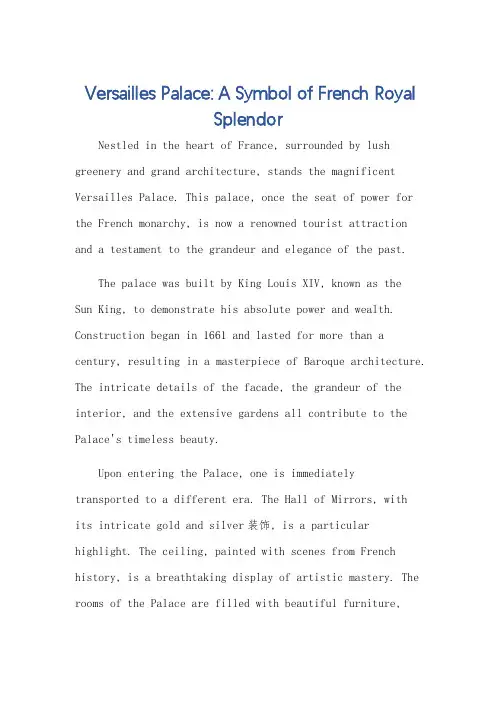
Versailles Palace: A Symbol of French RoyalSplendorNestled in the heart of France, surrounded by lush greenery and grand architecture, stands the magnificent Versailles Palace. This palace, once the seat of power for the French monarchy, is now a renowned tourist attraction and a testament to the grandeur and elegance of the past.The palace was built by King Louis XIV, known as theSun King, to demonstrate his absolute power and wealth. Construction began in 1661 and lasted for more than a century, resulting in a masterpiece of Baroque architecture. The intricate details of the facade, the grandeur of the interior, and the extensive gardens all contribute to the Palace's timeless beauty.Upon entering the Palace, one is immediatelytransported to a different era. The Hall of Mirrors, withits intricate gold and silver装饰, is a particular highlight. The ceiling, painted with scenes from French history, is a breathtaking display of artistic mastery. The rooms of the Palace are filled with beautiful furniture,tapestries, and paintings, all reflecting the taste and lifestyle of the French nobility.The Palace is not just a structure, but a symbol of the French monarchy's influence and power. It was here that King Louis XIV held court, entertaining guests with elaborate banquets and balls. The Palace was also the scene of many important political events, including the signing of the Treaty of Versailles in 1919, which ended World War I.Today, the Palace is open to the public, allowing visitors to explore its vast rooms and gardens. ThePalace's extensive collections of art and furniture are a testament to the cultural richness of France. The gardens, designed by Le Nôtre, are a peaceful oasis, filled with statues, fountains, and lush greenery.Versailles Palace is not just a tourist attraction, but a bridge to the past. It allows visitors to step into the shoes of the French nobility, to experience the grandeur and elegance of a bygone era. The Palace is a reminder of the rich history and cultural heritage of France, and a testament to the enduring power of art and architecture.**凡尔赛宫:法国皇家辉煌的象征**在法国的心脏地带,被茂密的绿植和宏伟的建筑环绕着,矗立着壮观的凡尔赛宫。

法国巴黎Paris拉法叶购物中心Galeriers Lafayette排水系统Sewer System 香榭丽舍大街Avenue des Champs Elysees蓬皮杜艺术中心The Pompidou Center击剑fencing swords 酿酒葡萄园vineryard法国是一个浪漫迷人的国家,也是世界最多游客前往的国家,巴黎是世界最多游人的都市,那充满品味的花都令人百游而不腻,但如果你认识法国只是巴黎,那你会损失很多,穿梭法国,深入一些鲜为人认识而又迷人的胜景,隆河阿尔卑斯迷人的胜地令神仙也心驰神往,碧水丹崖的科西嘉、奢华的罗亚尔河谷、神秘的中央山地、碧水蓝天的蔚蓝海岸、充满原始美态的庇里牛斯山、酒香弥漫的美酒之乡、熏衣草之乡的普罗旺斯、热闹迷人的尼斯华及芒果柠檬节,更有法国名厨英文名称:Eiffel Tower法文名称:La tour Eiffel别称:巴黎铁塔设计者:亚历山大·居斯塔夫·埃菲尔(Alexandre Gustave Eiffel)建设用途:餐厅、观景建设地点:法国巴黎战神广场开工时间:1887年1月27日竣工时间:1889年3月31日埃菲尔铁塔120岁生日亮灯埃菲尔铁塔从1887年起建,分为三楼,分别在离地面57.6米、115.7米和276.1米处,其中一、二楼设有餐厅,第三楼建有观景台,从塔座到塔顶共有1711级阶梯,共用去钢铁7000吨,12000个金属部件,259万只铆钉,极为壮观。
编辑本段文化象征1889年5月15日,为给世界博览会开幕式剪彩,铁塔的设计师居斯塔夫·埃菲尔亲手将法国国旗升上铁塔的300米高空,由此,人们为了纪念他对法国和巴黎的这一贡献,特别还在塔下为他塑造了一座半身铜像。
巴黎:跨塞纳河两岸,为法国第一大城市和举世闻名的旅游大城。
1)巴黎圣母院(Notre Dame de Paris)巴黎圣母院始建1163年,前后历时四百年才完工,是哥德式教堂的代表,精雕细凿,颇有鬼斧神工之能,尤其是正门三个大拱门上的浮雕,共有千余人物,非常细致。
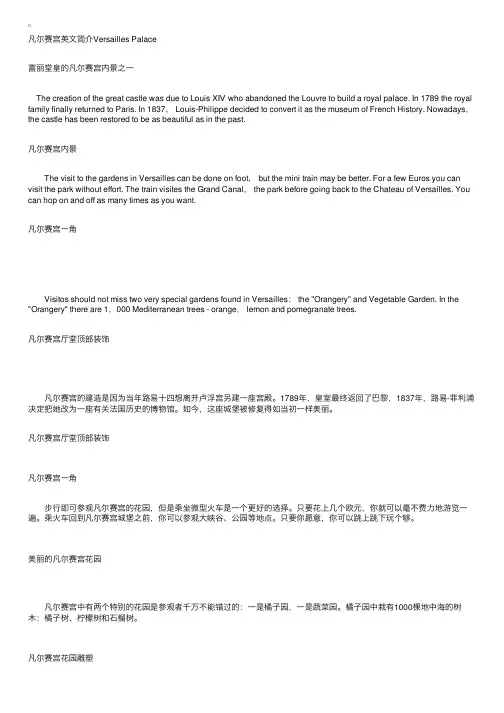
凡尔赛宫英⽂简介Versailles Palace富丽堂皇的凡尔赛宫内景之⼀ The creation of the great castle was due to Louis ⅩⅣ who abandoned the Louvre to build a royal palace. In 1789 the royal family finally returned to Paris. In 1837, Louis-Philippe decided to convert it as the museum of French History. Nowadays,the castle has been restored to be as beautiful as in the past.凡尔赛宫内景 The visit to the gardens in Versailles can be done on foot, but the mini train may be better. For a few Euros you can visit the park without effort. The train visites the Grand Canal, the park before going back to the Chateau of Versailles. You can hop on and off as many times as you want.凡尔赛宫⼀⾓ Visitos should not miss two very special gardens found in Versailles: the "Orangery" and Vegetable Garden. In the "Orangery" there are 1,000 Mediterranean trees - orange, lemon and pomegranate trees.凡尔赛宫厅堂顶部装饰 凡尔赛宫的建造是因为当年路易⼗四想离开卢浮宫另建⼀座宫殿。

中文词条名:凡尔赛宫英文词条名:Versailles Treaty1979年根据文化遗产遴选标准(I) (II) (VI)被列入《世界遗产目录》评为遗产的报告:世界遗产委员会第3届会议报告世界遗产委员会评价:凡尔赛宫,法国国王路易14世到路易16世的王宫,经过数代建筑师,雕刻家,装饰家,园林建筑师的不断改进,润色,一个多世纪以来,一直是欧洲王室官邸的第一典范。
简介:凡尔赛宫和园林是17世纪专制王权的象征,也是法国古典主义艺术最杰出的典范。
凡尔赛宫最初是路易十三修建的用于特猎的行辕,路易十四当政时开始建宫。
从1661年动工,到了1689年才得以完成。
宫殿主体达707米,有700多个房间,中间是子宫,两翼是宫室和政府办公处、剧院、教堂等。
室内地面、墙壁都用大理石镶嵌,并饰有雕刻、油画等装饰。
中部的镜厅是凡尔赛宫不同于其他皇宫的地方,长73米,宽100米,高12.3米。
拱顶是勒勃兰的巨幅油画。
长廊一侧是17面落地镜,镜子由483块镜片镶嵌而成,将外面的蓝天、绿树都映照出来,别有一番景色。
厅内两旁排有罗马皇帝的雕像和古天神的塑像,并有3排挂烛台、32座多支烛台和8座可插150支蜡烛的高烛台,经镜面反射可形成3000支烛台,映照得整个大厅金壁辉煌。
凡尔赛宫的园林在宫殿西侧,面积有100万平方米,呈几何图形。
南北是花坛,中部是水池,人工大运河、瑞士湖贯穿其间。
另有大小特里亚农宫及雕像、喷泉、柱廊等建筑和人工景色点缀。
放眼望去,跑马道、喷泉、水池、河流,与假山、花坛、草坪、亭台楼阁一起,构成凡尔赛宫园林的美丽景观。
凡尔赛宫位于距巴黎西部15千米的凡尔赛镇(另一资料:凡尔赛在离巴黎不到24公里的地方)。
她历史悠久,雄伟壮观。
作为其最著名部分的镜厅,更是尽显当年皇室的奢华之风。
其园林则具有欧洲古典园林艺术的风格特征。
而作为世界近代史上重大事件的见证地,更是使它闻名于世。
凡尔赛宫及其园林的总面积为1.11平方千米,其中建筑面积只占0.11平方千米,其余为园林面积。
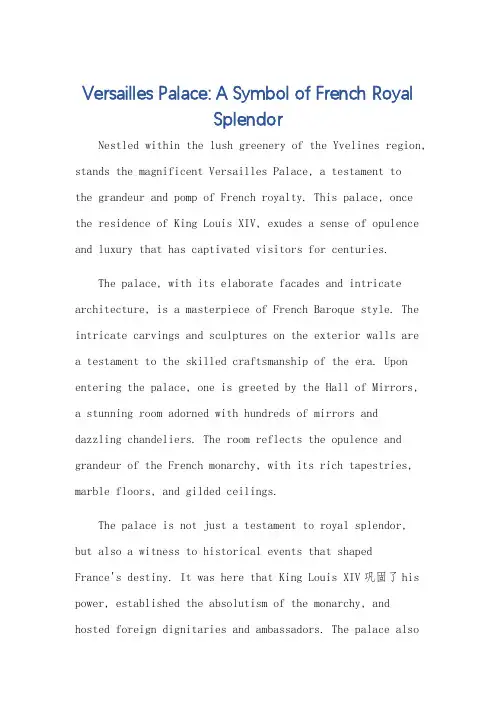
Versailles Palace: A Symbol of French RoyalSplendorNestled within the lush greenery of the Yvelines region, stands the magnificent Versailles Palace, a testament tothe grandeur and pomp of French royalty. This palace, once the residence of King Louis XIV, exudes a sense of opulence and luxury that has captivated visitors for centuries.The palace, with its elaborate facades and intricate architecture, is a masterpiece of French Baroque style. The intricate carvings and sculptures on the exterior walls are a testament to the skilled craftsmanship of the era. Upon entering the palace, one is greeted by the Hall of Mirrors, a stunning room adorned with hundreds of mirrors and dazzling chandeliers. The room reflects the opulence and grandeur of the French monarchy, with its rich tapestries, marble floors, and gilded ceilings.The palace is not just a testament to royal splendor, but also a witness to historical events that shapedFrance's destiny. It was here that King Louis XIV巩固了his power, established the absolutism of the monarchy, and hosted foreign dignitaries and ambassadors. The palace alsoplayed a pivotal role in the French Revolution, as it was the scene of many significant events that led to the downfall of the monarchy.Today, Versailles Palace stands as a national monument and a popular tourist destination. Visitors from around the world come to marvel at its grandeur and to relive the rich history of French royalty. The palace also hosts various cultural events and exhibitions, allowing visitors to delve deeper into the rich cultural heritage of France.The gardens of Versailles Palace are equally as impressive as the palace itself. Spanning over 800 hectares, the gardens are a perfect blend of nature and art. Withtheir对称布局, geometric designs, and elaborate fountains, the gardens provide a serene and peaceful setting forvisitors to relax and unwind. The Grand Canal, with its impressive water features and lush greenery, is aparticular highlight of the gardens.Versailles Palace is not just a physical structure; itis a symbol of French royal splendor and history. It tells the tale of a dynasty that rose to power,巩固了its authority, and eventually fell victim to the tides ofrevolution. Today, it stands as a reminder of the rich cultural heritage of France and a testament to the enduring power of art and architecture.**凡尔赛宫:法国皇家辉煌的象征**凡尔赛宫坐落于伊夫林地区郁郁葱葱的绿意之中,是法国皇家辉煌的象征,也是曾经的路易十四国王的居所。
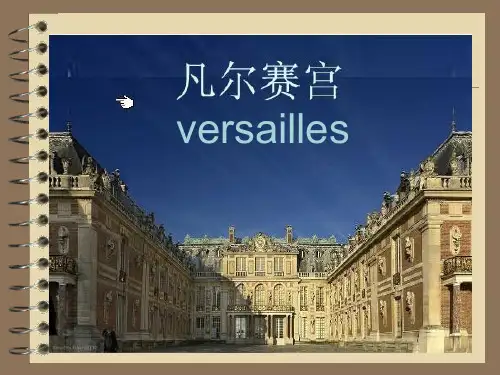
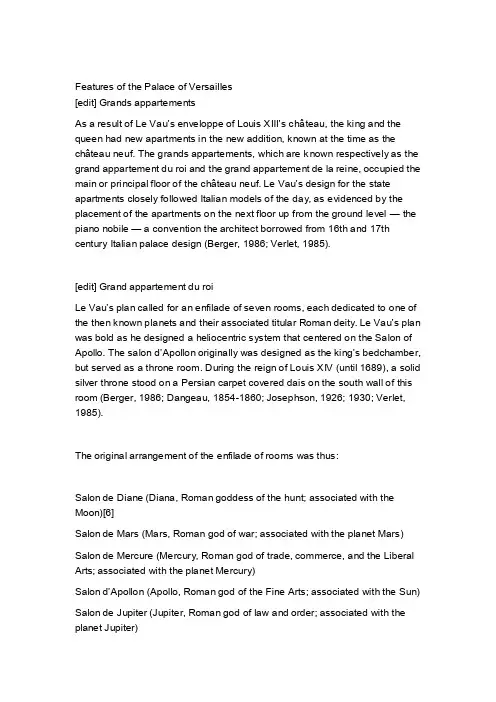
Features of the Palace of Versailles[edit] Grands appartementsAs a result of Le Vau’s enveloppe of Louis XIII’s château, the king and the queen had new apartments in the new addition, known at the time as thechâteau neuf. The grands appartements, which are known respectively as the grand appartement du roi and the grand appartement de la reine, occupied the main or principal floor of the château neuf. Le Vau’s design for the state apartments closely followed Italian models of the day, as evidenced by the placement of the apartments on the next floor up from the ground level — the piano nobile — a convention the architect borrowed from 16th and 17th century Italian palace design (Berger, 1986; Verlet, 1985).[edit] Grand appartement du roiLe Vau’s plan called for an enfilade of seven rooms, each dedicated to one of the then known planets and their associated titular Roman deity. Le Vau’s plan was bold as he designed a heliocentric system that centered on the Salon of Apollo. The salon d’Apollon originally was designed as the king’s bedchamber, but served as a throne room. During the reign of Louis XIV (until 1689), a solid silver throne stood on a Persian carpet covered dais on the south wall of this room (Berger, 1986; Dangeau, 1854-1860; Josephson, 1926; 1930; Verlet, 1985).The original arrangement of the enfilade of rooms was thus:Salon de Diane (Diana, Roman goddess of the hunt; associated with the Moon)[6]Salon de Mars (Mars, Roman god of war; associated with the planet Mars)Salon de Mercure (Mercury, Roman god of trade, commerce, and the Liberal Arts; associated with the planet Mercury)Salon d’Apollon (Apollo, Roman god of the Fine Arts; associated with the Sun)Salon de Jupiter (Jupiter, Roman god of law and order; associated with the planet Jupiter)Salon de Saturne (Saturn, Roman god of agriculture and harvest; associated with the planet Saturn)Salon de Vénus (Venus, Roman goddess of love; associated with the planet Venus)The configuration of the grand appartement du roi conformed to contemporary conventions in palace design (Baillie, 1967). However, owing to Louis XIV’s personal taste and with the apartment’s northern exposure, Louis XIV found the rooms too cold and opted to live in the rooms previously occupied by his father. The grand appartement du roi was reserved for court functions — such as the thrice-weekly appartement evenings given by Louis XIV for members of the court (Berger, 1986; La Varende, 1959; Marie, 1968, 1972; Nolhac, 1911; Verlet, 1985).The rooms were decorated by Le Brun and demonstrated Italian influences, the particularly that of Pietro da Cortona, with whom Le Brun studied while he was in Florence. Le Brun was influenced by the decorative style the da Cortona devised for the decoration of the Pitti Palace in Florence, which influenced his style Louis XIV at Versailles. The quadratura style of the ceilings evoke Pietro Cortona’s Sale dei Planeti at the Pitti, but Le Brun’s decorative schema is more complex (Blunt, 1980; Campbell, 1977). In his 1674 publication about the grand appartement du roi, André Félibien described the scenes depicted in the coves of the ceilings of the rooms as allegories depicting the “heroic actions of the king” (Félibien, 1674). Accordingly, one finds scenes of the exploits of Augustus, Alexander the Great, and Cyrus alluding to the deeds of Louis XIV (Lighthart, 1997; Sabatier, 1999). For example, in the salon d’Apollon, the cove painting “Augustus building the port of Misenum”[7] alludes to the construction of the port at La Rochelle; or,de picted in the south cove of the salon de Mercure is “Ptolemy II Philadelphus in his Library”, which alludes to Ptolemy’s construction of the Great Library of Alexandria and which accordingly serves as an allegory to Louis XIV’s expansion of the Bibliothèqu e du roi.[8] Complementing the rooms’ decors were pieces of massive silver furniture. Regrettably, owing to the War of the League of Augsburg, in 1689 Louis XIV ordered all of this silver furniture to be sent to the mint, to be melted down to help defray the cost of the war (Berger, 1986; Dangeau, 1854-1860; Josephson, 1926; 1930; Marie, 1968, 1972, 1976; Nolhac, 1911; Verlet, 1985).Le Vau’s original plan for the grand appartement du roi was short-lived. With the inauguration of the third building campaign, which suppressed the terrace linking the apartments of the king and queen, the salon de Jupiter, the salon de Saturne, and the salon de Vénus for the construction of the Hall of Mirrors, the configuration of the grand appartement du roi was altered. The decorative elements of the salon de Jupiter was removed and reused in the decoration of the salle des gardes de la reine; and elements of the decoration of the first salon de Vénus, which opened onto the terrace, were reused in the salon deVénus that we see today[9] (Marie, 1972, 1976; Nolhac, 1925; Verlet, 1985).From 1678 to the end of Louis XIV’s reign, the grand appartement du roi served as the venue for the king’s thrice-weekly evening receptions, known as les soirées de l’appartement. For these par ties, the rooms assumed specific functions:Salon de Vénus: buffet tables were arranged to display food and drink for the king’s guests.Salon de Diane: served as a billiard room.Salon de Mars: served as a ballroom.Salon de Mercure: served as a gaming (cards) room.Salon d’Apollon: served as a concert or music room.In the 18th century during the reign of Louis XV, the grand appartement du roi was expanded to include the salon de l’Abondance (Hall of Plenty) — formerly the entry vestibule of the petit appartement du roi — and the salon d'Hercule — occupying the tribune level of the former chapel of the palace (Verlet, 1985).[edit] Grand appartement de la reineForming a parallel enfilade with that of the grand appartement du roi, the grand appartement de la reine served as the residence of three queens of France —Marie-Thérèse d’Autriche, wife of Louis XIV, Marie Leczinska, wife of Louis XV, and Marie-Antoinette, wife of Louis XVI. Additionally, Louis XIV's granddaughter-in-law, Princess Marie-Adélaïde of Savoy, as duchesse deBourgogne, occupied these rooms from 1697 (the year of her marriage) to her death in 1712.[10]When Le Vau’s enveloppe of the château vieux was completed, the grand appartement de la reine came to include a suite of seven enfilade rooms with an arrangement that mirrored almost exactly the grand appartement du roi. The configuration was:Chapel — which was pendant with the salon de Diane in the grand appartement du roi[11]Salle de gardes — which was pendant with the salon de Mars in the grand appartement du roiAntichambre — which was pendant with the salon de Mercure in the grand appartement du roiChambre —which was pendant with the salon d’Apollon in the grand appartement du roiGrand cabinet — which was pendant with the salon de Jupiter in the grand appartement du roiOratory — which was pendant with the salon de Saturne in the grand appartement du roiPetit cabinet — which was pendant with the salon de Vénus in the grand appartement du roi[12]As with the decoration of the ceiling in the grand appartement du roi, which depicted the heroic actions of Louis XIV as allegories from events taken from the antique past, the decoration of the grand appartement de la reine likewise depicted heroines from the antique past and harmonized with the general theme of a particular room’s decor.[13]With the construction of the Hall of Mirrors, which began in 1678, the configuration of the grand appartement de la reine changed. The chapel was transformed into the salle des gardes de la reine and it was in this room that the decorations from the salon de Jupiter were reused.[14] The salle des gardes de la reine communicates with a loggia that issues from the escalier dela reine, which formed a parallel pendant (albeit a smaller, thoughsimilarly-decorated example) with the escalier des ambassadeurs in the grand appartement du roi. The loggia also provided access to the appartement du roi, the suite of rooms in which Louis XIV lived, and to the apartment of Madame de Maintenon. Toward the end of Louis XIV's reign, the escalier de la reine became the principal entrance to the château, with the escalier des ambassadeurs'' used on rare state occasions. After the demolition of the''escalier des ambassadeurs'' in 1752, the ''escalier de la reine'' became the main entrance to the château (Verlet, 1985). From 1682, the ''grand appartement de la reine'' included:Salle des gardes de la reineAntichambre (formerly the salle des gardes)Grand cabinetChambre de la reineWith the death of Louis XIV in 1715, the court moved to Vincennes and shortly after to Paris. In 1722, Louis XV reinstalled the court at Versailles and began modifications to the château’s interior. Among the most noteworthy of the building projects during Louis XV’s reign, th e redecoration of the chamber de la reine must be cited.To commemorate the birth of his only son and heir, Louis-Ferdinand, in 1729, Louis XV ordered a complete redecoration of the room. Elements of the chamber de la reine as it had been used by Marie-Thérèse d’Autriche and Marie-Adélaïde de Savoie were removed and a new, more modern decor was installed[15] (Marie, 1984; Reynaud and Villain, 1970; Verlet, 1985).During her life at Versailles, Marie Leczinska lived in the grand appartement de la reine, to which she annexed the Salon of Peace to serve as a music room. In 1770, when the Austrian archduchess Maria Antonia married the dauphin, later king Louis XVI, she took up residence in these rooms. Upon Louis XVI’s ascension to the throne in 1774, Marie-Antoinette ordered major redecoration of the grand appartement de la reine. At this time, the queen’s apartment achieved the arrangement that we see today (Verlet, 1985).Salle des gardes de la reine — this room remained virtually unchanged by Marie-Antoinette.[16]Antichambre — this room was transformed into the antichambre du grand couvert. It was in this room that the king, queen, and members of the royal family dined in public. Occasionally, this room served as a theater for thechâteau.Grand cabinet — this room was transformed into the salon des nobles. Following the tradition established by her predecessor, Marie-Antoinette would hold formal audiences in this room. When not used for formal audiences, the salon des nobles served as an antechamber to t he queen’s bedroom. Chambre de la reine —this room was used as the queen’s bedroom, and was of exceptional splendor. On the night of 6/7 October 1789, Marie-Antoinette fled from the Paris mob by escaping through a private corridor that connected her apartment with that of the king.。
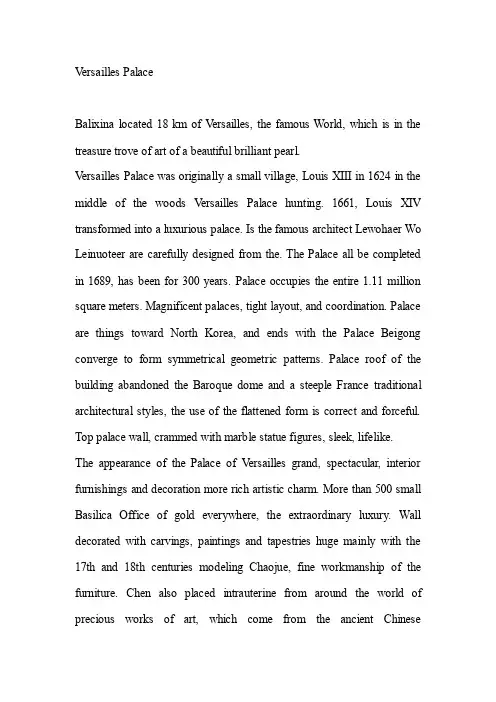
V ersailles PalaceBalixina located 18 km of V ersailles, the famous World, which is in the treasure trove of art of a beautiful brilliant pearl.V ersailles Palace was originally a small village, Louis XIII in 1624 in the middle of the woods V ersailles Palace hunting. 1661, Louis XIV transformed into a luxurious palace. Is the famous architect Lewohaer Wo Leinuoteer are carefully designed from the. The Palace all be completed in 1689, has been for 300 years. Palace occupies the entire 1.11 million square meters. Magnificent palaces, tight layout, and coordination. Palace are things toward North Korea, and ends with the Palace Beigong converge to form symmetrical geometric patterns. Palace roof of the building abandoned the Baroque dome and a steeple France traditional architectural styles, the use of the flattened form is correct and forceful. Top palace wall, crammed with marble statue figures, sleek, lifelike.The appearance of the Palace of V ersailles grand, spectacular, interior furnishings and decoration more rich artistic charm. More than 500 small Basilica Office of gold everywhere, the extraordinary luxury. Wall decorated with carvings, paintings and tapestries huge mainly with the 17th and 18th centuries modeling Chaojue, fine workmanship of the furniture. Chen also placed intrauterine from around the world of precious works of art, which come from the ancient ChineseY uandiechongxiang exquisite porcelain.In front of the Palace is a unique style of the French-style garden. Bibo the foreground are two pools, ponds and plastic along the bronze Fengzi polymorphic provisions. When in 1789 when Louis XVI, the sumptuous palace of V ersailles, the extravagant luxury, to the limit, no point to be added. Finally aroused the indignation of the people, during the Revolution, the Palace of V ersailles was almost deserted. Until 1837, before re-Louis Philippe repair, it read French History, the exhibition paintings, sculptures, and many other works of art.Today, the Palace of V ersailles is a world famous tourist attractions, visitors come States, the number of visitors every year to more than 200 million. Palace and the Palace North and the South is the bottom Louis Phillips has been into a museum, collecting a large number of precious portraits, sculpture, paintings and other huge history of art. Apart from the Palace of V ersailles for the tourists, the French president and other leaders have often been at the dinner meeting or national leaders, and diplomats.。
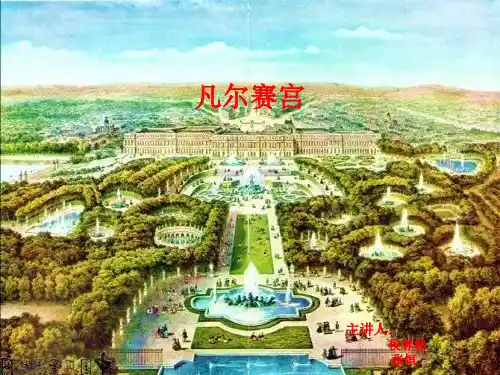
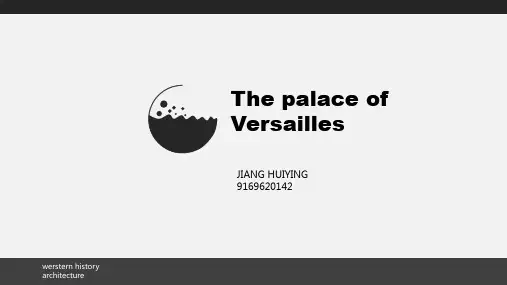
【凡尔赛宫的导游词】凡尔赛宫的导游词300字凡尔赛宫(法文:chateaudeversailles)位于法国巴黎西南郊外伊夫林省省会凡尔赛镇,是巴黎著名的宫殿之一,也是世界五大宫殿之一(北京故宫、法国凡尔赛宫、英国白金汉宫、美国白宫、俄罗斯克里姆林宫)。
1979年被列为《世界文化遗产名录》。
凡尔赛宫是一座古典风格的建筑。
立面采用标准的经典三段式处理,即立面分为垂直和水平两部分。
建筑左右对称,外形轮廓整齐、庄严、雄伟。
它被称为理性美的代表。
其内部装饰主要为巴洛克风格,少数大厅为洛可可风格。
凡尔赛宫的建筑风格引起了俄罗斯、奥地利等国君主的钦佩和模仿。
彼得一世在圣彼得堡郊外建造的颐和园、玛丽亚·特雷西亚在维也纳建造的美丽的春天宫殿、弗雷德里克二世和弗雷德里克·威廉二世在波茨坦建造的无忧无虑的宫殿,以及巴伐利亚国王路德维希二世建造的施洛舍伦希姆宫,都模仿凡尔赛宫和花园。
然而,凡尔赛宫过分追求宏伟和奢华,但其生活功能却不方便。
宫殿里没有厕所,甚至王子也不得不在卧室的壁炉里大便。
路易十五非常厌恶这间卧室,认为尽管它宽敞豪华,却不能保暖。
凡尔赛宫的主要景观集中在主楼和花园的二楼。
凡尔塞宫举世闻名的凡尔塞宫位于巴黎西南18公里的凡尔塞镇,建于路易十四时代,1661年动土,1689年竣工,至今约有290年的历史。
全宫占地111万平方米,其中建筑面积为11万平方米,园林面积100万平方米。
宫殿建筑气势磅礴,布局严密、协调。
正宫东西走向,两端与南宫和北宫相衔接,形成对称的几何图案。
宫顶建筑摒弃了巴洛克〔巴洛克〕17~18世纪发展起来的一种建筑和装饰风格。
其特点是外形自由,追求动态效果,喜好富丽的装饰和雕刻以及强烈的色彩,常用曲线穿插和椭圆形空间。
的圆顶和法国传统的尖顶建筑风格,采用了平顶形式,显得端正而雄浑。
在宫殿外墙的上端,有大理石雕像和雕像,它们美丽而栩栩如生。
它是人类艺术宝库中一颗璀璨的明珠。